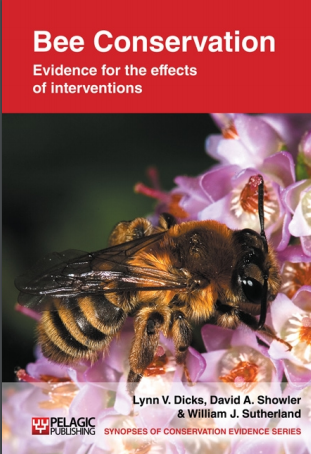Reintroduce laboratory-reared bumblebee colonies to the wild
-
Overall effectiveness category Awaiting assessment
-
Number of studies: 8
View assessment score
Hide assessment score
How is the evidence assessed?
-
Effectiveness
not assessed -
Certainty
not assessed -
Harms
not assessed
Study locations
Supporting evidence from individual studies
In a replicated trial that introduced 20 commercially-reared colonies of the buff-tailed bumblebee Bombus terrestris terrestris into farms and 10 into suburban gardens in the UK in early June (Goulson et al. 2002), colonies produced an average of 160 workers. The production of new queens was variable, with averages from 21 to 36 queens/colony and no significant difference between gardens and farmland. Colonies in gardens were significantly more likely to be infested by the damaging bumblebee wax moth Aphomia sociella (average 77 larvae/nest, compared to 3-4 larvae/nest on farmland).
Study and other actions testedA replicated controlled trial in Canada tested the effect of feeding captive-reared bumblebee colonies (29 colonies of the common eastern bumblebee B. impatiens, 16 colonies of the red-belted or tricolored bumblebee B. ternarius) sited in a flower-rich meadow, with sucrose solution and fresh pollen (Pelletier & McNeill 2003). Twenty-one colonies that were fed produced 56% more workers, and were almost four times as likely to produce new queens as those that were not fed. Fed colonies produced between 0 and 19 queens/colony on average, and control colonies between 0 and 14 queens/colony (the paper gives separate averages for each species and each year). Social parasitism by cuckoo bees was high in this study, with between one quarter and two thirds of colonies successfully usurped. The rate was not reduced by supplementary feeding.
Study and other actions testedA trial with three laboratory-reared colonies of B. terrestris introduced to an agricultural landscape in Vestby, Norway (Dramstad et al. 2003) found that greater numbers of marked bumblebees from the colonies foraged on a 210 x 2 m sown strip of phacelia Phacelia tanacetifolia when the nests were moved more than 100 m away from the strip (18.3 marked bumblebees/210 m transect) than when they were placed right next to it (11.5 marked bumblebees/ 210 m transect).
Study and other actions testedWhittington & Winston (2004) placed seven laboratory-reared colonies of the rapidly declining Western bumblebee B. occidentalis in agricultural land and woodland in British Columbia, Canada, and compared the numbers of bees and brood with seven similar colonies prevented from foraging but supplied with water and pollen. Both groups were supplied with sugar syrup. Outside colonies produced as many workers (40-80 workers per colony on average) and more brood than enclosed colonies, but after five weeks, their syrup supply was robbed by honey bees Apis mellifera, resulting in high bumblebee mortality.
Study and other actions testedIngs et al. (2006) placed seven laboratory-reared colonies of the native UK subspecies B. t. audax in field locations in Surrey, England. These colonies were left out until the founding queen died and all males and queens had emerged. They produced an average of 0.3 queens and 189 males/colony. Only two of the seven colonies produced any queens.
Study and other actions testedA replicated trial using 48 commercially-reared colonies of B. t. terrestris in the UK shows that rates of parasitism by cuckoo bees Bombus [Psithyrus]spp. can be high on colonies in nest boxes (38 colonies, 79% parasitized; Carvell et al. 2008). Parasitism is more intense when colonies are sited in areas of high resource availability (92% of colonies parasitized by three cuckoo bees on average among oilseed rape Brassica napus fields, compared to 67% parasitized by one cuckoo bee on average among wheat fields). Parasitism is also more intense if colonies are placed early in the season (early May). This suggests that if captive-reared colonies of native bumblebees are to be reintroduced, they should be placed out later in the season (early June), amongst a heterogenous landscape with intermediate levels of resource.
Study and other actions testedWhitehorn et al. (2009) placed 36 laboratory-reared colonies of B. terrestris (non-native subspecies, probably terrestris or dalmatinus)in field conditions at the University of Stirling, Scotland, from when they had 15 workers until the founding queen died. The experiment included inbred colonies and colonies with diploid males. Normal colonies (no diploid males) produced a total of 30-31 workers on average, but no new queens. Sixteen outbred colonies survived for an average of 4.5 weeks, but did not produce new queens.
Study and other actions testedA replicated trial using 19 captive-reared colonies of the long-tongued bumblebee species B. appositus in subalpine meadows in Colorado, USA, found that four colonies regularly fed with sugar solution did not produce significantly more workers, males or queens than 15 colonies that were not fed (Elliott 2009).
Study and other actions tested
Where has this evidence come from?
List of journals searched by synopsis
All the journals searched for all synopses
This Action forms part of the Action Synopsis:
Bee Conservation
Bee Conservation - Published 2010
Bee Synopsis





)_2023.JPG)














